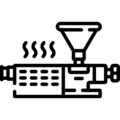
Processing Of Rubber
Rubber, whether natural or synthetic, arrives at processor (fabricator) plants in large bales.
Once the rubber arrives at the factory, processing goes through following steps: compounding & mixing, shaping and vulcanizing.
First of all, Large bales of the Rubber is cut into small pieces by the Bale Cutter Machine.


Compounding
The compounding is the first step of the Rubber Moulding Process. It decides the Properties of the final Rubber Products.
Compounding adds chemicals and other additives to customize the rubber for the intended use. All the chemicals which are to be added in the rubber are calculated as per the standard formulas.
Chemicals added during compounding react with the rubber during the vulcanizing process to stabilize the rubber polymers. Additional additives may include reinforcing fillers to enhance the properties of the rubber or non-reinforcing fillers to extend the rubber. The kind of filler used depends on the final product.


Mixing
Mixing is a very important process. The mixture which is made ready in the Compounding stage, is thoroughly mixed in the Automatic machines.
Primary stage: Kneader Machine
Secondary stage: Mixing Mill
We have all the in-house set up for the Mixing of the compounds.


Extrusion
Process consists of forcing highly plastic rubber through a series of screw extruders.
The Die is placed in the front of the machine to make the desired shape of the Rubber strip.
The extruded profile is in the unvulcanised form , which can be cured later in the Boiler or CV line.


Vulcanization
completes the Moulding process.
Vulcanization creates the cross-connections between the polymers of rubber with the applied temperature & pressure.
After the specified time , The product is ejected from the Mould.

Technical Requirements
| Properties | NBR | EPDM | NEOPRENE | SILICONE | FLUORO SILICONE | VITON |
|---|---|---|---|---|---|---|
| Hardness, A | 40-95 | 30-85 | 30-90 | 40-80 | 60-80 | 50-95 |
| Heat Reasustance Max Cont. Deg. C | 100 | 130 | 150 | 205 | 205 | 205 |
| Low Temp Resistance | -20 | -50 | -35 | -60 | -80 | -20 |
| Oxidation Resistance | Good | Excellent | Very Good | Excellent | Excellent | Out- standing |
| Ozone and Weathering | Fair | Out- standing | Very Good | Out- standing | Out-standing | Out- standing |
| Oil Resistance | Excellent | Fair | Good | Excellent | Excellent | Excellent |
| Solvent:- Alcohol | Good | Good | Good | Good | Good | Good |
| -Acetone | Poor | Good | Fair | Fair | Poor | Poor |
| -Benzene | Poor | Poor | Poor | Poor | Good | Good |
| Chemical:- Acids | Good | Good | Good | Fair | Fair | Excellent |
| -Bases | Fair | Good | Fair | Fair | Fair | Good |
| Physical Strength | Good | Good | Good | Poor | Good | Good |
| Compression Set | Good | Good | Good | Good | Good | Good |
| Tear and Abrasion | Good | Good | Good | Poor | Poor | Good |
| Resilience | Good | Very Good | Vey Good | Fair | Fair | Poor |
| Gases Permeability | Good | Fairly Loe | Very Good | Good | Good | Very low |
| Electrical Strength | Poor | Excellent | Good | Excellent | Good | Good |
| Flame Resistance | Poor | Poor | Self Extinguishing | Good | Good | Good |
| Water Resistance | Good | Excellent | Good | Good | Good | Good |

